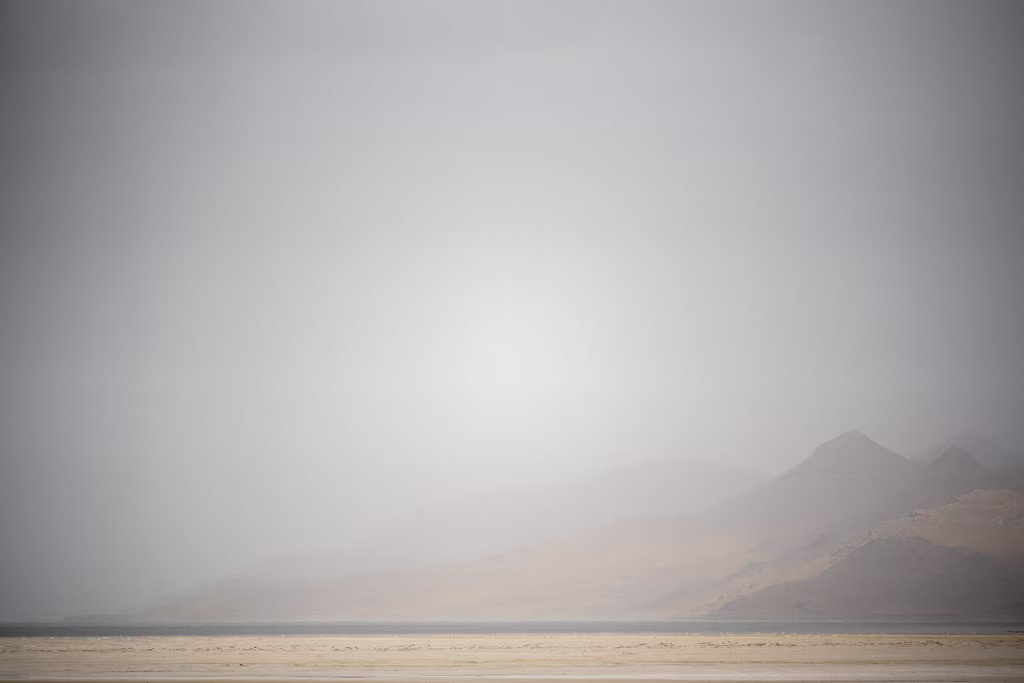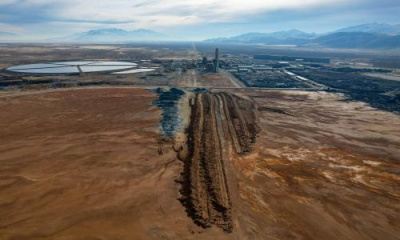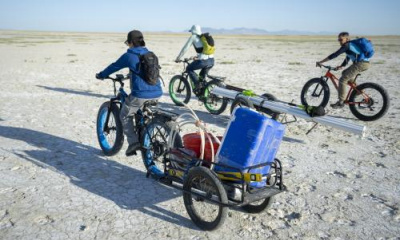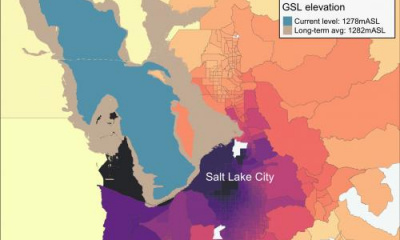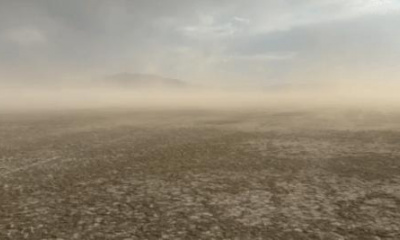One community activist on Salt Lake County’s west side is ready for solutions, not just studies, about air quality and environmental injustice.
“It’s been known for years that this has been going on and we’re still studying it, which makes Terry Marasco a little buggy,” Marasco said, referring to himself. “That’s my big complaint about the history of the west side. Everybody studies and the dust keeps coming and we don’t do anything about it.”
But one researcher said she is hopeful a new study about the distribution of dust from the Great Salt Lake’s exposed lake bed will help spur action to get more water to the lake and help solve at least one of the long-documented issues with the west-side’s air quality.
Sara Grineski, a sociology and environmental studies professor at the University of Utah, acknowledged there have been many studies but said the one she and other researchers recently published “relates where we expect the dust to go to where people live.”
She also argued it’s “a bit hopeful” by demonstrating that raising lake levels can lead to less dust and less environmental injustice.
Grineski joined with six other university researchers to study actual dust storms and created advanced models based on different lake levels to connect dots to people, she said.
The study found what most people already know – everyone who lives near the Great Salt Lake faces potentially unhealthy levels of dust exposure, but the risks are worse for racial and ethnic minorities living on the west side of the Salt Lake Valley.
Researchers also found disparities based on education levels, Grineski said, but not based on household income.
Models of dust storms at four different lake levels showed disparities getting worse as lake levels drop and better as the Great Salt Lake reaches a level state officials define as healthy.
That reinforces what Deputy Great Salt Lake Commission Tim Davis calls a “tongue-in-cheek” solution to problems with dust – getting enough water to the lake.
Meanwhile, the state is working on eight priorities related to dust from the drying lake bed, Davis said, including more monitoring, dust modeling and real-time public education tools.
Dust pollution has short- and long-term health effects
It’s no secret that the west side faces greater issues with air quality than the rest of the Salt Lake Valley.
“There’s a history of many years of all kinds of toxics in the air coming to the west side,” Marasco said.
And even at current lake levels, modeling shows dust concentrations – based on particulate matter measuring 2.5 micrometers or less in diameter, or PM 2.5 – are much higher in West Valley City, Magna and other communities close to the lake and highways.
Exclusionary policies, such as redlining and cheaper land, meant many Pacific Islanders and Latinos put down roots in those west-side communities closer to the Great Salt Lake, the Bingham Canyon Mine and such highways as Interstate 80.
The dust off the lake creates unique problems though, Marasco said, including arsenic and “all sorts of other debris from the lakebed.” Arsenic is a known carcinogen, according to the National Cancer Institute.
Dr. Brian Moench, president of Utah Physicians for a Healthy Environment, said other heavy metals, forever chemicals and infectious microorganisms can all be suspended in dust coming off the dry lake bed.
Even standard dust, without all those other dangerous additives, can wreak havoc and damage the body’s systems.
Because PM 2.5 particles, which the study measured, are so small, they can travel deep into the lungs and other human tissues. The smallest dust particles, less than 0.1 micrometers in size, can even get into human cells.
Dust pollution can exacerbate existing health conditions by, for example, triggering asthma attacks or allergy responses. More than one in 10 residents in many of Salt Lake City’s west-side neighborhoods have asthma already, among the highest rates along the Wasatch Front.
Jocylin Meza, who coordinates the Salt Lake County Health Department’s asthma program, said most of the home visits conducted through the program are on the west side.
The program determines asthma burden by emergency room visits, she said, and numbers on the west side are higher than both the state average and visits on the east side of Salt Lake County.
The county completes the free program, including three in-home visits, with around 50 people a year, Meza said, and has completed 3,585 visits since its inception in 2015.
And it’s making a difference, she said – within the last three years, 83% of people who completed the program had controlled asthma a year later, and all the participants in the past year have avoided going to the hospital for an asthma attack.
Education is the program’s biggest goal, Meza said.
“A lot of people aren’t aware how dust and air pollution can affect all of us,” she said. “Long-term exposure is a risk for everyone, not just people with asthma.”
Beyond long-term effects, each dust event puts people at risk of serious health emergencies, Moench said.
“Within an hour after inhaling air pollution, your blood pressure starts to rise,” Moench said, “and that causes your blood vessels to constrict and that sets you up for this cascade of inflammation, fatty deposit buildup, further occlusion of your arteries and then you’re at risk for a heart attack or stroke, all those kind of things.”
Modeling: Socially disadvantaged groups benefit most from a healthy lake, suffer most if lake dries up
Grineski and the other researchers found that while current lake levels result in dust storms that disproportionately harm westside residents, it could get worse.
Models in the study show if the lake continues to dry up, people of color who live in the Salt Lake Valley will be exposed to even more dust than their white counterparts due to historical patterns of settlement and exclusion, putting them more at risk of developing health issues.
For the study, the researchers looked at dust storms from April and May 2022, when increases in PM 2.5 occurred simultaneously with strong winds. They used data from the Utah Department of Environmental Quality’s PM 2.5 monitors.
Derek Malia, a research assistant professor at the University of Utah’s Department of Atmospheric Sciences, created models of dust distribution at four different lake levels, varying from a completely dry lake bed to a “healthy lake,” based on the state’s definition of between 4,198 and 4,205 feet above sea level.
Those models showed that as lake levels decreased, inequities widened – and vice versa.
There was a “pretty strong” disparity related to education levels, Grineski said, but a “much bigger difference” when considering residents’ race and ethnicity.
For example, typical exposure to PM 2.5 at current lake levels is 25.7 micrograms per cubic meter of air during a dust storm, but that varies by race from a concentration of 25.36 for people identifying as white to 27.67 for those identifying as Pacific Islander.
That’s a 9.1% difference, and people identifying as Pacific Islander are exposed to PM 2.5 concentrations that are 7.6% higher than the estimate for all people within the study area.
The gap shrinks to 6.7% for people identifying as Pacific Islander at a healthy lake level of around 4,199 feet above sea level but widens to 13.9% if the lake dries up entirely.
Grineski tried a few different methods to see if household income was a factor, but “just didn’t find big differences.”
Overall, people in socially disadvantaged groups – racial and ethnic minorities, those with no high school diploma and renters – experience the greatest decrease in dust exposure if the lake reaches its target healthy level, according to the modeling.
Conversely, those same groups suffer the most if the lake dries up.
For example, the models estimate dust concentrations for people identifying as Pacific Islander would decrease by about 7% with a “healthy” lake but increase by more than 30% if the lake completely dried up.
“If we don’t see a shift in trends toward conserving water, we will see the lake dry up and we’ll see it dry up faster and faster each year,” said Carmen Valdez, a policy associate with Healthy Environment Alliance of Utah. “What that means for the communities and the disparities for those living on that front line is they’re going to experience worse fugitive dust storms.”
‘Hopeful story’ but lots of work to go
That possibility highlights what Grineski said is a key point and purpose of the study: Introducing another reason to get more water to the lake.
Less dust everywhere and narrowing the gap in exposure – especially for people who already are disadvantaged – is an “additional benefit on top of other benefits” that would come from getting the lake to its target healthy level, she said.
“Raising the water levels in the lake can make a difference for people’s health,” Grineski said. “It’s not one of those situations where we’re completely helpless.”
The state is working to get more water to the lake, Davis said, but there may be short-term options to manage dust pollution until that happens.
The commissioner’s office recently held a “Great Salt Lake Dust Forum” and identified priorities to address dust pollution, including:
- Increased investment in improved monitoring for dust. Davis said that needs to include equipment that can monitor concentrations of dust as well as what it contains.
- More research into dust hot spots, contaminants in the dust and dynamics of the exposed lake bed crust.
- Efforts to develop a better understanding of the health implications of Great Salt Lake dust.
- Remote sensing to estimate and monitor crust and hot spot development.
- Models to characterize and differentiate dust from the Great Salt Lake and other sources.
- Cost-effective mitigation measures that can help while the state works to secure enough water to get the lake to its healthy target range.
- Real-time public education tools.
- Quarterly meetings to get feedback on studies and implementation.
There’s a lot the state doesn’t know about the dust, Davis said, so the priorities focused on that are important.
The biggest goal is still to get more water to the lake, he said, but there might be short-term options, such as wetting the playa periodically to try and reform the crust that keeps dust from blowing off the lake bed.
Officials don’t want to get to a point where they’re managing the decline – like California is for many of its lakes – instead of trying to increase water levels, he said.
“We want to get the lake to the healthy target range,” Davis said. “I do think it’s a hopeful story. We just have a lot of work to do.”

